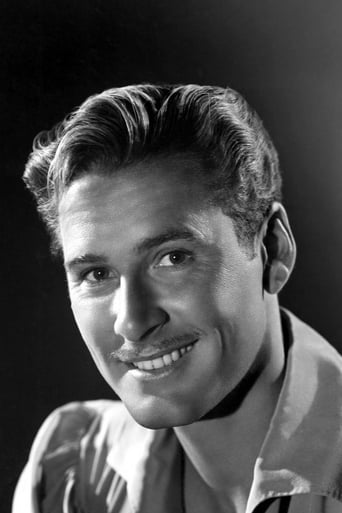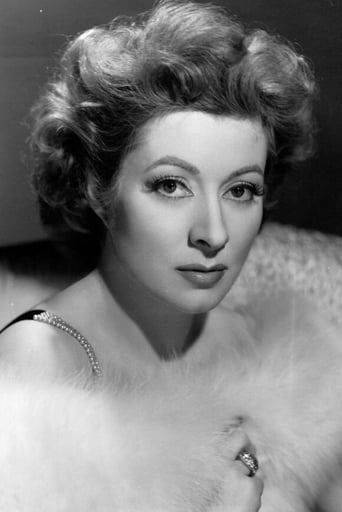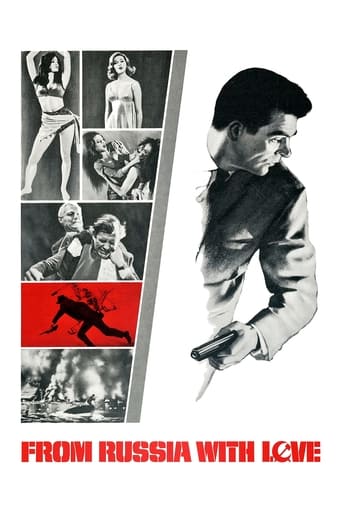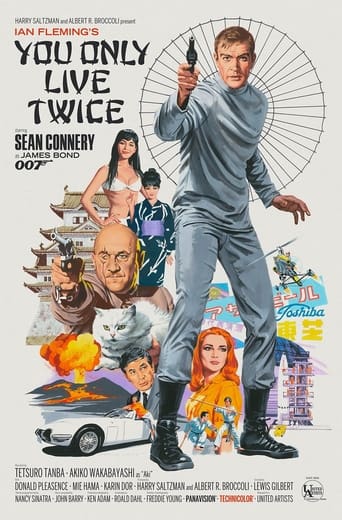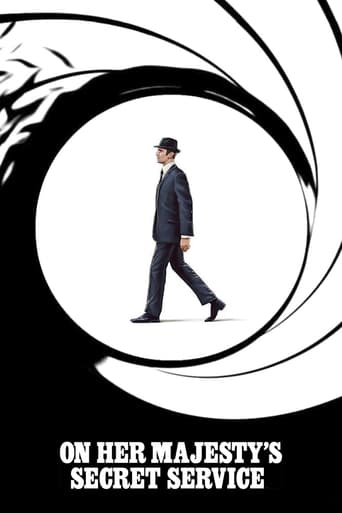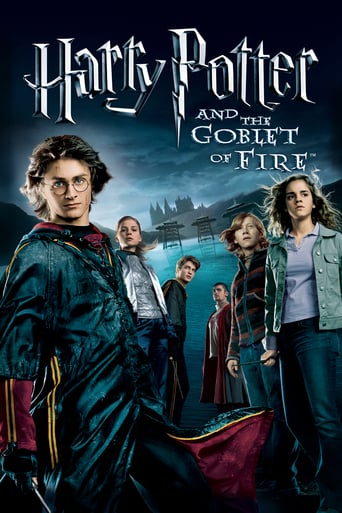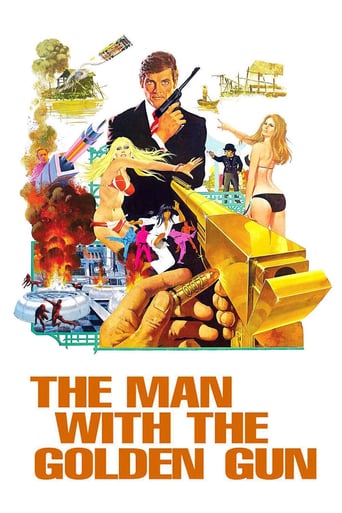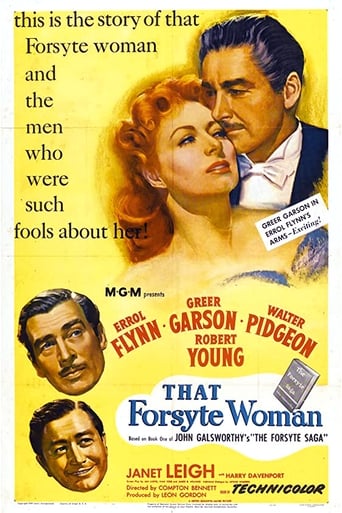
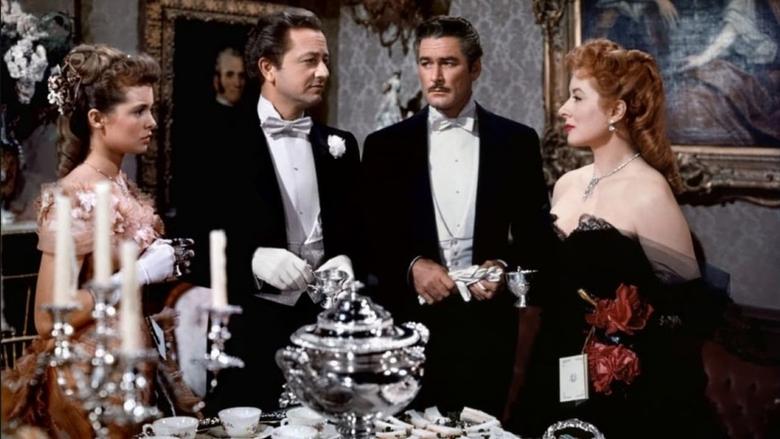
That Forsyte Woman (1949)
Soames and Irene Forsyte have a marriage of convenience. Young Jolyon Forsyte is a black sheep who ran away with the maid after his wife's death. Teenager June Forsyte has found love with an artist, Phillip Bosinny. The interactions between the Forsytes and the people and society around them is the truss for this love story set in the rigid and strict times of the Victorian age.
Watch Trailer
Cast
Similar titles
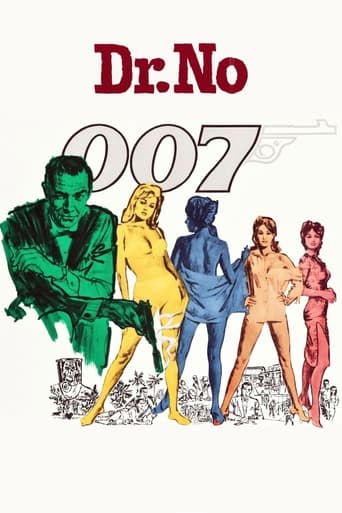
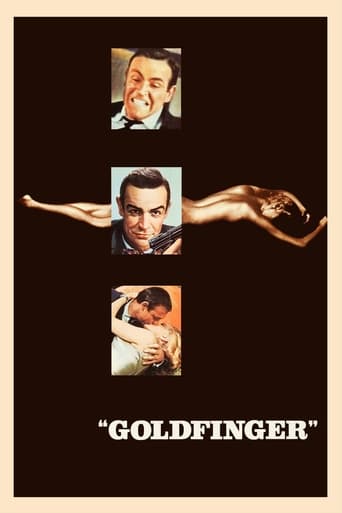
Reviews
Captivating movie !
Boring
The film never slows down or bores, plunging from one harrowing sequence to the next.
The story, direction, characters, and writing/dialogue is akin to taking a tranquilizer shot to the neck, but everything else was so well done.
I originally saw this in the early 70s, after having seen THE FORSYTE SAGA on TV, and reading the first three books. Shoehorning two books' worth of story into a two-hour movie makes mincemeat out of the plot, but the essential details are preserved.It was a crackup for me to see Robert Young, then widely known as Marcus Welby M.D. I was used to seeing him as an old man; but then he looks old for the part anyway, and overacts to compensate for it.However, Errol Flynn is excellent as Soames, and Walter Pidgeon brings the necessary gravitas to the role of Jolyon. Harry Davenport is fine as Old Jolyon, although I can't quite erase the image of Dr. Meade from Gone With the Wind.It's not a very good adaptation of Galsworthy's story, but on its own merits, it's well acted and edited, with handsome production design and nice pacing. It's fun to watch just to compare it with the more successful TV version.
Because there is (for the most part) a sense of fun and adventure in the best of Errol Flynn's movies movie lovers tend not to see that he could perform well in dramatic fashion. I can site two examples: 1) In DAWN PATROL he starts cracking up under the stress and strain of his command position; 2) In THEY DIED WITH THEIR BOOTS ON, Flynn senses that he is going to probably die on his last military mission (as does his wife Olivia de Havilland). But they kid and joke together about how they'll retire and grow fat together once the campaign is over. So he could act very well indeed. But the hijinks that were part of his films usually covered his abilities to act. Then there was Jack Warner. He rarely agreed to let Flynn do "straight" dramatic or comic roles. In Flynn's early career he did do films like GREEN LIGHT, FOUR'S A CROWD, and THE SISTERS with mediocre results (the comedy FOUR'S A CROWD is the best of this bunch), but Warner knew how the public liked certain actors as dramatic players and certain ones in particular grooves. He rarely gave Flynn a non-adventure part after 1940. The murder mystery FOOTSTEPS IN THE DARK, the all star romp THANK YOUR LUCKY STARS, and the interesting French war drama UNCERTAIN GLORY were exceptions I suspect this treatment began to bug Flynn after the rape case in 1944, when Warner's was determined (for damage control) to try to retain Flynn's hero image at all costs, and to make his sexuality a type of joke. Then, his contract with Warners ended and he went to M.G.M. He was able to do THAT FORSYTE WOMAN with Greer Garson, Walter Pigeon, and Robert Young. Here, he hoped, he would demonstrate his abilities as a straight actor as never before. THAT FORSYTE WOMAN is based on THE FORSYTE SAGA's first novel, THE MAN OF PROPERTY (with a bit of the second novel IN CHANCERY thrown in). Written by John Galsworthy in the teens and twenties, the nine novels and numerous short stories and "interludes" about members of his rich, upper middle class family remain a favorite series of tales about the period of England from 1880 to 1929 (Galsworthy died in 1933). They won him the Nobel Prize in Literature. Unfortunately, the stories' appeal has led to them being used for television twice, the last time only four years ago. The best version is either that recent one, or the 1960s version starring Kenneth More, Eric Porter, Nyree Dawn Porter, Martin Jarvis, Susan Hampshire, Nicholas Pennell, and (introducing) Michael York. I say unfortunately because the television versions (being multiple episodes) allowed the screenwriters more opportunity to dramatize more of the stories. Whole plot lines, jettisoned or condensed in a single film (even of a single novel) were expanded more comprehensibly. Also, as the 1960s version was going through the first six novels in 26 hour episodes, characters were given a chance to develop. In particular Soames Forsyte, the character played by Flynn in the movie.In the 1960s version Soames was played by Eric Porter. Now it is an odd balance here. Porter had no great film career - he did not become the film icon that Flynn did. But on television he certainly was quite effective in several programs (he was a memorable Nevil Chamberlain in WINSTON CHURCHILL: THE WILDERNESS YEARS). His version of Soames was a wonderful full blooded characterization. Instead of just being a stuffed - shirt solicitor and art collector, Porter showed the demons that drive Soames to the mad act that blights his home life (Soames sexually attacks an unwilling Irene - his wife - when she refused to fulfill her wifely duties). Later his stuffiness actually stands out in rather good contrast to the anti-Victorian backlash that follows the First World War. He becomes a grand old curmudgeon.Flynn could not do this. Indeed the entire rape issue in the novel was totally played down in the film (MGM brass could not bring up the idea of rape with Flynn, even though he had won the 1944 case brought against him on that charge). Instead they emphasized the other unattractive side of Soames. Committed to property, in his art collecting, his accumulation of wealth, and his home (and his future house being built by Philip Bossiney (Robert Young)), the movie Soames considers Irene (Greer Garson) his possession. In the novel this theme is brought out by Galsworthy (typical of the mindset of Victorian England - even in it's laws). Irene tries to escape with Bossiney (who is engaged to Soames cousin June (Janet Leigh)), but the latter dies under violent circumstances. However, Irene does leave Soames, and ends up marrying Soames other cousin Jolyon (Pidgeon).With the total affect of the novel cut due to the mores of 1949 and the history of it's male leading man, the story was weakened. To his credit Flynn did give a good performance. He is a totally unlikeable Victorian pompous ass who happens to have no sense of humor (which is Soames' character, before his marriage problems) who likes to collect things. Problem is, even with his money it is hard to understand why anyone would be willing to marry such a man. Irene (in the novel) is the daughter of a professor who has died, and is living with her step-mother (whom she can't stand). If this was developed (as it was in the 1960s series) the problem of her marrying Soames would be understood. Here it wasn't.As the story was done so superbly by Porter and his co-stars in the 1960s, Flynn's good performance in such a mediocre version is distinctly minor. However, out of respect for Errol's attempt to show what he could do (and his personal results) I'll give the film a "7" as a better than average try.
This film was cited as one of the ones that Errol Flynn felt he gave a good performance in, and that assessment is certainly true. He completely played against type in this role as an emotionally restricted man of property and did a fine job. The problem is not in his playing but in the heavily edited screenplay and miscasting. Robert Young is laughable as the "young" architect and Greer Garson too genteel by half for the role of the scheming adulteress Irene who freezes Soames out-Eleanor Parker would have been ideal for this role,but one gets the feeling MGM couldn't allow Garson to be the adventuress the role demanded because of her image. Also,the film's lack of the pivotal rape scene that ends the marriage in the novel undermines the reason why Irene detests Soames so much. Flynn portrays Soames well enough that he could have followed through in such a scene in good form. He did a great job with this character's motivations and was still quite handsome. An underrated performance in a so-so adaptation of a classic novel.
I'm not surprised that many viewers find this film frustrating, particularly those unfamiliar with the novels or the later TV adaptations - coming to this film with such knowledge definitely helps one be more charitable towards it.THAT FORSYTE WOMAN is one of MGM's "prestige" literary productions, tackling the first novel of one of Britain's most beloved series of novels by one of its most beloved authors, John Galsworthy. It's another well-executed, professional MGM effort. Yet it's another strange choice for MGM (as was THE PICTURE OF DORIAN GRAY earlier in the decade), since in this case the story's main plot is an adulterous affair,casting its two leading players (Flynn and Garson) very much 'against type' - one can't blame Flynn for being willing, but I'd like to know just exactly which MGM executive thought to cast Greer Garson as the adulteress! The lady was simply too likable!These are complex characters, and it actually took Galsworthy 6 novels to reveal them fully to the reader. Neither Soames nor Irene (the Garson role) are particularly likable in the first novel - both seem selfish and willful, but the reader ultimately comes to understand both of them better (although Galsworthy never really does give a satisfactory reason for Irene's loathing of Soames).MGM originally produced the film under the title THE FORSYTE SAGA (I have a copy of the movie tie-in edition of the novel published by Scribners in 1949)) but, since the film was merely a slice of the Saga anyway, they changed the title to the more catchy THAT FORSYTE WOMAN emphasizing Irene's 'fast' nature. It remained THE FORSYTE SAGA in the UK.One has to admire MGM's ambitious attempt, but let's face it, they'd really bitten off more than they could chew: THE FORSYTE SAGA was too big, too rich, and too multi-layered for one film. Rather, it was a work destined for success in another medium which was still in its infancy - television, in a format to which its breadth, length and varied cast of characters would be perfectly suited - the "mini-series", for which it would provide the pioneer effort with spectacular success in the late 1960s.
